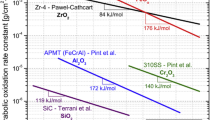Conclusions
During the firing of specimens of silicon carbide and silicon in a nitrogen atmosphere at 1200–1400°C, the silicon is converted almost completely to silicon nitride. The content of impurities of SiO2 and Si varies from 1.7 to 1%, and from 2.8 to 0.5% respectively.
The compressive strength of the specimens, depending on the firing temperature, is 2500−1750 kg/cm2, the porosity 17–18%, and the solubility in cryolite-alumina melt 10.0−2.5μ/h.
The minimum firing temperature of the specimens is 1200°C, and the soaking time at this temperature should not be less than 6 h. The maximum firing temperature is 1400°C with a 3-h soak.
Silicon carbide refractories for the linings of aluminum electrolyzers need to be fired with a staged cycle, with soaking periods at 1200 and 1400°C.
Similar content being viewed by others
Literature cited
I. S. Brokhin and B. F. Funke, Ogneupory, No. 12, 562 (1957).
D. Mirew and I. Schopow, Chem. Techn.,12, No. 12, 714 (1960).
Author information
Authors and Affiliations
Additional information
Translated from Ogneupory, No. 12, pp. 23–29, December, 1967.
Rights and permissions
About this article
Cite this article
Voronin, N.I., Krasotkina, N.I. & Fraifel'd, M.S. Firing silicon carbide refractories in a nitrogen atmosphere. Refractories 8, 745–751 (1967). https://doi.org/10.1007/BF02055730
Issue Date:
DOI: https://doi.org/10.1007/BF02055730




